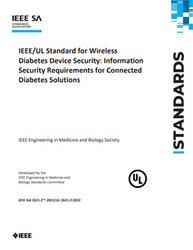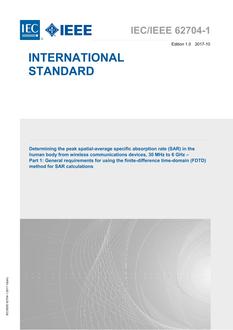Wireless Communication
Search Results
-
IEEE 2621.2-2022 /UL 2621-2-2022
IEEE/UL Standard for Wireless Diabetes Device Security: Information Security Requirements for Connected Diabetes Solutions
standard by IEEE, 05/13/2022.
Languages: English
- MULTI-USER
-
IEEE 2857-2021
IEEE Standard for Wireless Smart Utility Network Field Area Network (FAN)
standard by IEEE, 06/25/2021.
Languages: English
- MULTI-USER
-
IEEE/IEC 62209-1528-2020
IEC/IEEE International Standard - Measurement procedure for the assessment of specific absorption rate of human exposure to radio frequency fields from hand-held and body-mounted wireless communication devices - Part 1528: Human models, instrumentation, and procedures (Frequency range of 4 MHz to 10 GHz)
standard by IEEE/IEC, 10/19/2020.
Languages: English
Historical Editions: IEEE 1528-2013, IEEE 1528-2003
- MULTI-USER
-
IEEE/IEC 62704-1-2017
IEC/IEEE International Standard for Determining the Peak Spatial Average Specific Absorption Rate (SAR) in the Human Body from Wireless Communications Devices, 30 MHz - 6 GHz. Part 1: General Requirements for using the Finite Difference Time Domain (FDTD) Method for SAR Calculations
standard by IEEE/IEC, 10/27/2017.
Languages: English
- MULTI-USER
-
IEEE/IEC 62704-2-2017
IEEE/IEC International Standard -- Determining the peak spatial-average specific absorption rate (SAR) in the human body from wireless communications devices, 30 MHz to 6 GHz -- Part 2: Specific requirements for finite difference time domain (FDTD) modelling of exposure from vehicle mounted antennas
standard by IEEE/IEC, 06/30/2017.
Languages: English
Amendments, rulings, and supplements: IEEE/IEC P62704-2a
- MULTI-USER
-
IEEE/IEC 62704-3
IEC/IEEE Approved Draft International Standard - Determining the Peak Spatial-Average Specific Absorption Rate (SAR) in the Human Body from Wireless Communications Devices, 30 MHz - 6 GHz Part 3: Specific Requirements for using the Finite Difference Time Domain (FDTD) Method for SAR Calculations of
standard by IEEE/IEC, .
Languages: English
- MULTI-USER
-
IEEE/IEC 62704-3-2017
Determining the Peak Spatial-Average Specific Absorption Rate (SAR) in the Human Body from Wireless Communications Devices, 30 MHz - 6 GHz Part 3: Specific Requirements for Using the Finite Difference Time Domain (FDTD) Method for SAR Calculations of Mobile Phones
standard by IEEE/IEC, 10/27/2017.
Languages: English
- MULTI-USER
-
IEEE/IEC 62704-4-2020
IEC/IEEE International Standard - Determining the peak spatial-average specific absorption rate (SAR) in the human body from wireless communication devices, 30 MHz to 6 GHz - Part 4: General requirements for using the finite element method for SAR calculations
standard by IEEE/IEC, 10/19/2020.
Languages: English
- MULTI-USER
-
IEEE/IEC 62704-5
IEC/IEEE International Draft Standard - Determining the power Density of the Electromagnetic Field Associated with Human Exposure to Wireless Devices Operating in Close Proximity to the Head and Body Using Computational Techniques, 6 GHz to 300 GHz
standard by IEEE/IEC, .
Languages:
- MULTI-USER
-
IEEE/IEC 63195-2-2022
IEC/IEEE International Standard - Assessment of power density of human exposure to radio frequency fields from wireless devices in close proximity to the head and body (frequency range of 6 GHz to 300 GHz)--Part 2: Computational procedure
standard by IEEE/IEC, 05/10/2022.
Languages: English
- MULTI-USER









